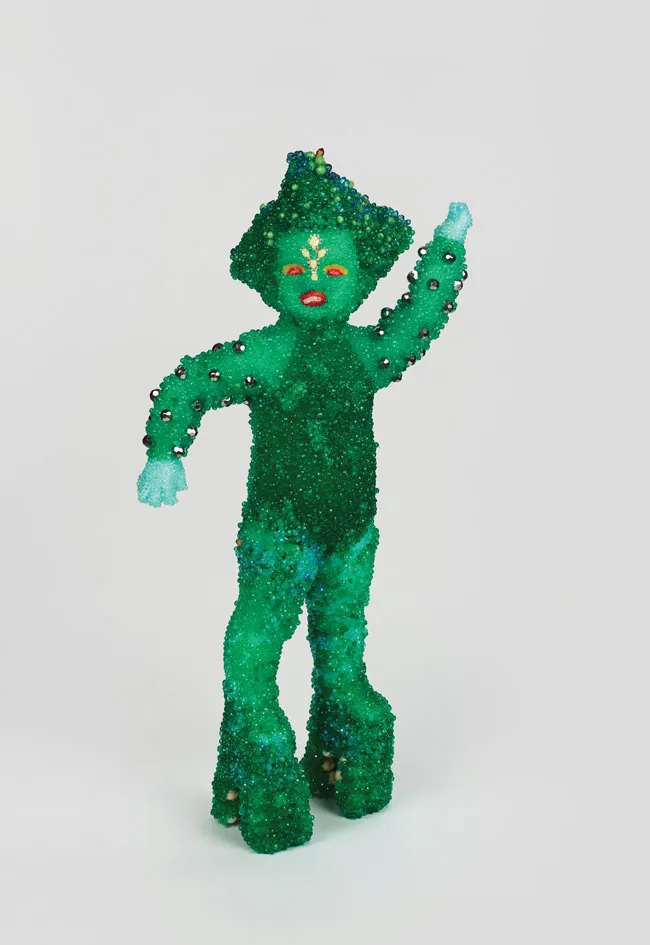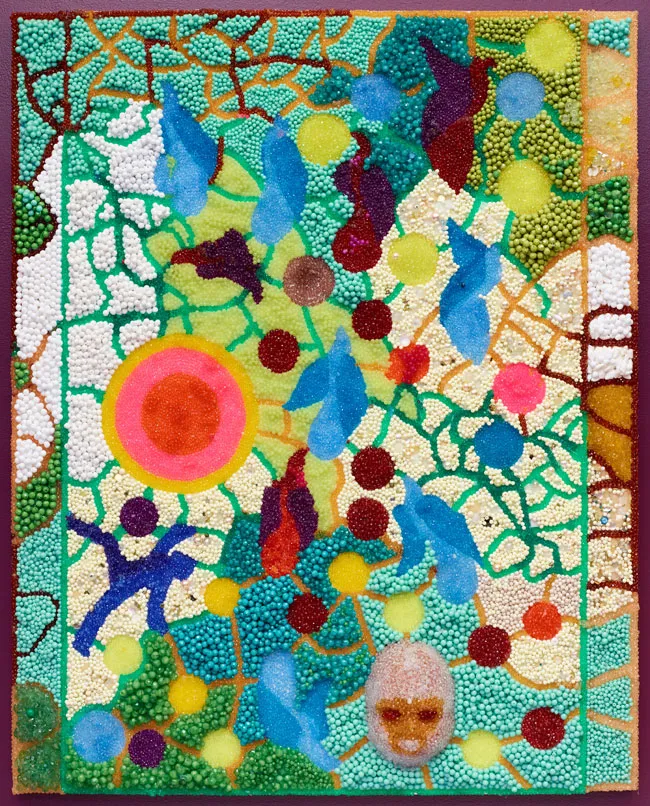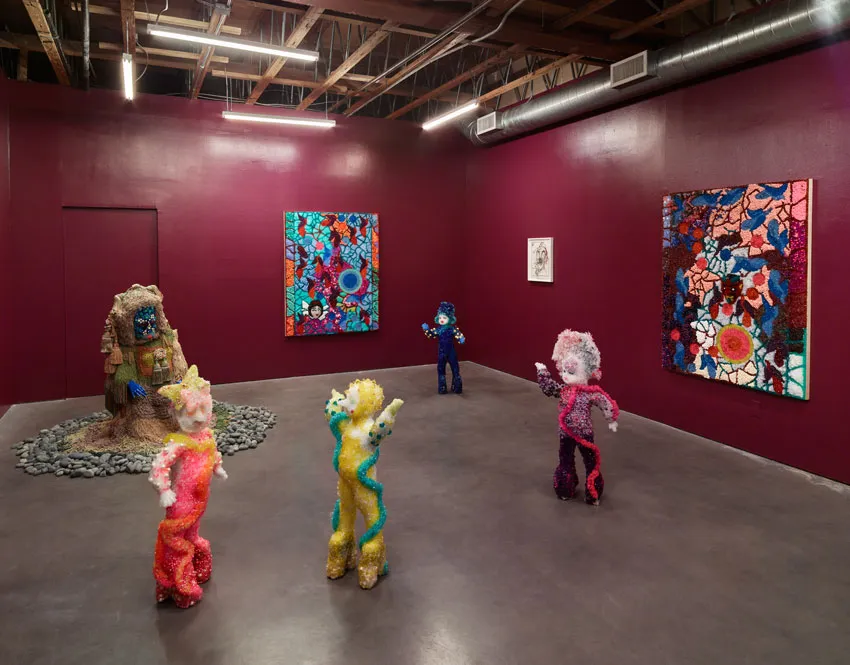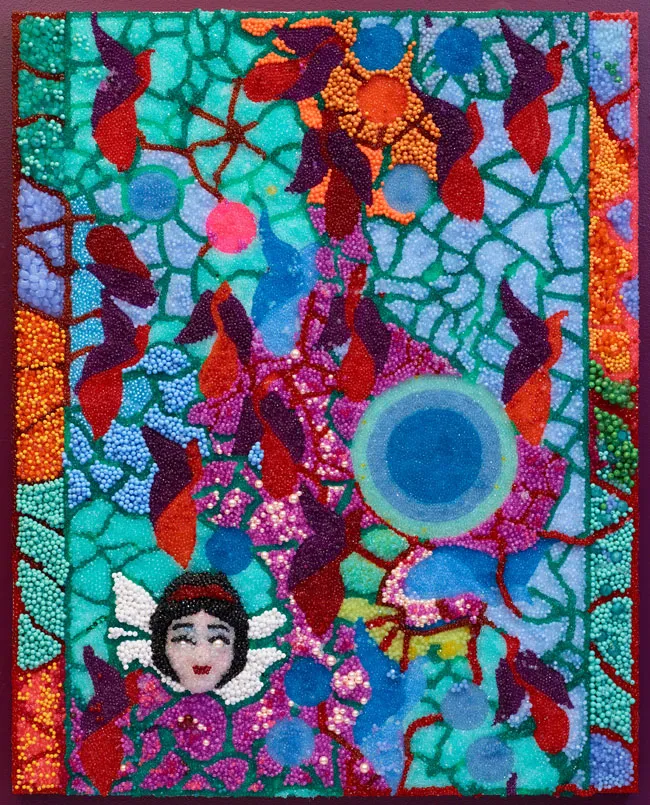
- Source: CAR.LA
- Author: AARON HORST
- Date: JANUARY 22, 2019
- Format: PRINT AND ONLINE
Raúl de Nieves at Freedman Fitzpatrick

Raúl de Nieves, Evie (2018). Image courtesy of the artist and Freedman Fitzpatrick, Los Angeles/Paris. Photo: Marten Elder.
I had just finished the chapter about Times Square in Vanishing New York before stepping of the bus onto the still-tawdry eastern edge of Hollywood Boulevard. Freedman Fitzpatrick’s gallery is in a two-story strip mall just a few blocks from the start of the walk of fame—or on the fringes of tourism’s exhaustion. Hollywood, at least for a few blocks, maintains a kind of Times Square lite vibe—appreciably scuzzy, sometimes outright scary, if not as strange as the “Hollyweird” captured in the 1980 film Foxes with its buskers, hookers, and dogs wearing sunglasses.
In Freedman Fitzpatrick’s main, and only, room, six bedazzled little figures in platforms disperse, preening and gesturing, maybe towards each other or maybe at something unseen. Seemingly alien-human hybrids with cherubic faces, encrusted, or engulfed, head to toe in plastic beading, they could’ve wandered in from a few decades ago. They have monosyllabic, sassy-teen names—Evie, Rosha, Bethany (all works 2018)—all registered on the image list for The Guide, Raúl de Nieves’ first solo show at the gallery. Their daring haircuts and dated, if not archaic, platform shoes evince 1970s glam—that is, glamour with the corners cut. These creations of de Nieves elephant-stomp their way into the ice-cool business of the contemporary art world with a curiously refreshing kind of garish bad taste— though I wonder where it is within contemporary art that they might actually go.

Raúl De Nieves, Spring (2018). Plastic bead, glue, wood, 60 x 48 x 2 ½ inches. Image courtesy of the artist and Freedman Fitzpatrick.
The bright, brash, and cheap, pushed to the point of circus-like surreality, has as its conceptual underpinnings the idea of reinvention. One might then read de Nieves’ works as the manifestation— wholly in costuming, accessorizing, and plumage—of a formerly latent identity. Aside from the smaller sculptures, the singular, larger Psychopomp looms in the corner, laden with tassels and vintage trim. Electric blue mannequin hands reach out from under the weighty, fancy folds of fabric, and a skirt of rocks surrounds the figure’s pooling yarnwork. On the wall, black and white charcoal drawings on vellum show clown-y faces and figurations; the elaborate make-up and costuming in each often bleeds into abstract geometries in the background.
These drawings, all titled Fool (I, II, and III), alternate with panels encrusted with yet more plastic beads, each evoking something between stained glass and a Lite Brite board. Summer, one of the panels, could be a pool scene—blue and green sections divvied up along meandering lines like light shining through water. In the lower left, tight beadwork forming the face of Disney’s Cinderella floats, her image static and doll-like. Similar faces appear in the other panels, including that of the devil (Autumn) and a witch (Winter). Each of these faces lurk in meandering fields of color and shape, suggestive of aerial landscapes. Each also contains a beaded disk of varying color, which might be read as a sun or planetary body. By contrast, the charcoal drawings, though sinister, point at something perhaps more tender—the composition of a self, exaggerated and even monstrous, constructed layer by detailed layer until recognition of the original begins to blur, the process overwhelmed by its culmination.

Raúl de Nieves, The Guide (2018) (installation view). Image courtesy of the artist and Freedman Fitzpatrick.
Something more disquieting comes to mind when considering de Nieves’ ostensible subject—the resourceful formulation and expression of an entirely new, weird self—and the way in which the artist brings it into being through the manipulation of easily available, cheap, and abundant plastics. All the beading and hot glue in de Nieves’ works inhabit a contradiction in the simplest way—heavy in look, light in weight, and, art being in part in thrall to the discerning eye, one might get a cheap thrill out of identifying so much cheap material. Yet whether he intends it or not, his employ of these plastics contributes directly to their supply and demand. (Reeling somewhat from the onslaught of plastic in the show on the bus ride home, I added a note about recycling to my Grindr profile.) De Nieves’ works are thus inorganic in an almost asphyxiating way.
Reinvention as a conceptual ground is a kind of perennial, relatable identity politic. The press text consists entirely of a poem speaking to fear, contemporary anxiety, and the desire to create a new self not through meticulous work but through the drama of a sudden leap: “…the only thing I want to do / is jump / so that I could / float / maybe so / I will come out / a new self.” Perhaps it is axiomatic to note that the narrative here, in achieving its explicitly personal appeal, is entirely self-centered in its consideration of anxiety, unwilling or unable to comprehend the holistic, global impact and ethical conundrums of individual decisions.

Raúl De Nieves, Summer (2018). Plastic bead, glue, wood, 60 x 48 x 2.50 inches. Image courtesy of the artist and Freedman Fitzpatrick.
Also, the ornate ostentatiousness of de Nieves’ work comes not from a leap, but from hours of tedious care, as if divining some aspect of the authentic self from laboring over the base ingredients of the false. Authenticity lies somewhere in this soup of class, performance, surrealism, and intricacy. But de Nieves ultimately cloaks the specter of the authentic, leaving it a tacit, unseen structure on which wild fantasy figures instead.

